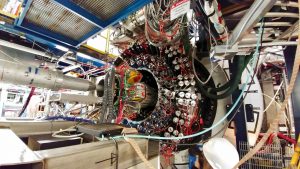
Atomic nuclei are made up by protons and neutrons (or nucleons) that together constitute more than 99% of the visible matter in the universe. They are made by elementary constituents, quarks and gluons, whose interactions are described by the Quantum Chromo Dynamics (QCD).
The nucleons are objects so complex that even their most basic properties, like the mass and the spin, are still very hardly described within the QCD. For example, the Higgs mechanism explains the quark masses, but the quarks determining the total electric charge of the nucleons are responsible for only about 1% of the mass and 30% of the spin of the nucleons. The CLAS experiment explores the nucleon internal structure with a precision never reached in past experiments, using electron beams with high luminosity, energy and polarization impinging on (both polarized or unpolarized) targets of hydrogen or heavier nuclei, detecting the particles produced in the collision.
The INFN contributed to the CLAS12 spectrometer construction with a Ring Imaging Cherenkov (RICH) detector, that exploits the Cherenkov effect to identify high energy charged kaons.
 INFN-LNF Laboratori Nazionali di Frascati
INFN-LNF Laboratori Nazionali di Frascati